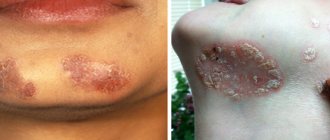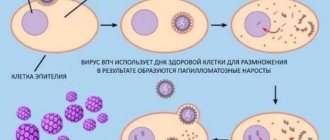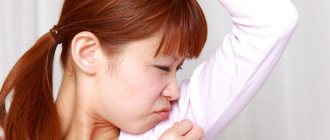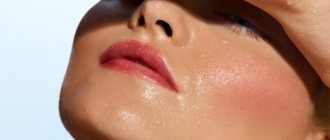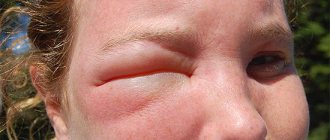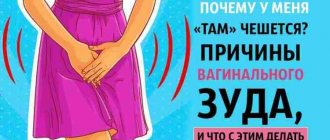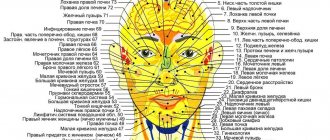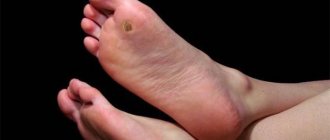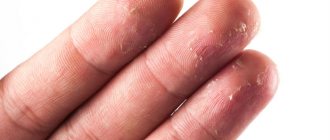Characteristics and forms of hyperhidrosis
Severe sweating in a child can be general or localized. In the first case, they speak of a diffuse type of hyperhidrosis, which manifests itself in conditions of high air temperature, significant physical or emotional stress, and instability of the nervous system. The second refers to a local form of increased sweating that can affect certain areas of the body:
- palms;
- feet;
- facial area;
- axillary, popliteal cavities.
Localized hyperhidrosis in children is accompanied by a failure of thermoregulation caused by certain disorders. Quite often it occurs with VSD (vegetative-vascular dystonia).
Characteristic symptoms
Hyperhidrosis is an unpleasant condition for both the child and his parents. It is accompanied by profuse sweating and dermatological problems (redness of the skin, itching, rash). Often, after a night's rest, the baby's bed and pajamas become damp, and he himself suffers from sleep disturbances.
Excessive sweating leads to constant negative emotions. A child suffering from hyperhidrosis is subject to increased anxiety, often becomes whiny, overly impressionable and touchy, and loses a healthy appetite. In stressful situations, the skin of such children may become blotchy and itchy.
Causes
There are factors that provoke the problem at certain times of the day:
- During the day . Hyperhidrosis in a child often occurs as a result of overheating and wearing clothes made of low-quality synthetic materials. Children of the first year of life sweat due to daytime activity and prolonged stay in a hot, unventilated room. For the same reasons, increased sweating is observed in a 2-3 year old child.
- At night . The baby may sweat if there is no properly organized night rest (on down pillows and feather beds, in pajamas made of artificial fabric). Hyperhidrosis is provoked by a lack of ventilation, active games shortly before bedtime, and an overly rich dinner, which leads to increased work of the body at night.
According to pediatricians, the optimal temperature for children's sleep is 18-20°C. The humidity level should be within 50-60%. Violation of such recommendations can cause hyperhidrosis even in absolutely healthy children and adolescents.
The causes of sweating in children may be associated with excess weight. It is known that varying degrees of obesity interfere with normal thermoregulation. Also, hormonal changes in the body, taking certain types of antibiotics, and a hereditary tendency to hyperhidrosis lead to increased sweating.
Why do my feet and palms sweat?
Sweaty feet in children often occur when wearing low-quality shoes that interfere with normal air circulation. Feet become wet when wearing insoles made of artificial material or using rubber products.
Wet palms are a sign of excessive sweating in children, which is hereditary. Moisture also appears on your hands during moments of experiencing intense emotions, which can be both positive and negative.
Excessive sweating in a 5-year-old child is not always considered an anomaly. At this age, periodically occurring moisture in the palms or feet can be considered normal. During this period of life, the cause of sweating in a child is the active formation of sweat glands, which continues until the 7-8th birthday.
Wet head and neck
Increased sweating in young children, observed in the head and neck area, often occurs against the background of violent emotional outbursts or physical activity. In babies of the first year of life, this phenomenon is often observed during breastfeeding.
A condition in which the head and neck become wet is not a cause for concern in most cases. It can be considered as a pathology if the moisture has an unpleasant odor or, in addition to increased sweating, there are other negative symptoms (decreased appetite, tachycardia, difficulty breathing, digestive problems, insomnia, increased nervousness).
Your child's age
Quite an important thing. In the mother's belly, the baby does not need thermoregulatory function. Any formation of it begins at about the age of 1 month, it reaches maturity by 4-5, less often by 6 years, sometimes by 9. So if an infant begins to sweat a lot from time to time, and there are no other alarming symptoms, then there is no need to worry about There is no need to treat it with anything.
Until 2-3 years of age, the formation of the autonomic nervous system, which regulates autonomic functions in the body, is also completed, and at this age the child may sweat a lot from time to time. Apart from hygiene, he doesn’t need anything else. In adolescents under 15 years of age, hormonal levels change; the child almost no longer sweats a lot - this is also normal.
Diseases accompanied by sweating
The cause of excessive sweating in a child may be internal pathology. Sometimes hyperhidrosis develops in the presence of certain diseases, such as:
- ARVI, influenza;
- chronic infections;
- adenoids;
- diabetes;
- hyperfunction of the thyroid gland;
- rheumatism;
- rickets;
- cardiovascular diseases;
- pathologies of the biliary tract;
- lymphatic diathesis;
- latent tuberculosis.
With vegetative-vascular dystonia, sweat secretion occurs in various areas of the body. Also, a small patient may be bothered by frequent headaches, dizziness, loss of strength, and decreased mental and physical activity.
Should I see a doctor?
In many cases, hyperhidrosis can be eliminated or minimized by:
- changing children's daily routine;
- avoiding overheating;
- frequent ventilation of the room;
- refusal of synthetic clothing and shoes;
- reducing psycho-emotional stress;
- protecting the child from stressful situations.
Sleeping on underwear made of natural fabric and avoiding active games in the evening can help reduce severe night sweats in a child. A visit to a doctor is required when hyperhidrosis occurs for a reason not related to the negative impact of external factors. In such cases, it is worth contacting a pediatrician who will conduct a medical examination and give the necessary recommendations.
Improper care as a consequence of hyperhidrosis
Often parents themselves create the conditions for hyperhidrosis. For example, they dress their children too warmly, including at night. As a result, the child sweats. The cause may also be high temperature in the room. For infants, the optimal room temperature is 20-22 degrees, for older children - 18-20. The children's room, just like the entire apartment, should be regularly ventilated.
Factors of improper care include the following:
- clothing that is too warm when walking;
- overwork, irregular nutrition and unregulated daily routine;
- rare bathing;
- lack of sleep.
Diagnostic methods
When reporting complaints of hyperhidrosis, you will need:
- visual inspection of the skin;
- taking biochemical blood and urine tests;
- X-ray examination;
- cardiac electrocardiogram (ECG);
- Ultrasound diagnostics.
Additionally, other methods of examining the patient can be used to provide an expanded understanding of the existing disorder. These include:
- gravimetry, which allows you to assess the degree of palmar, axillary and plantar hyperhidrosis, measuring the rate of sweating;
- evapometry, which determines the rate of TEWL (transepidermal water loss);
- Minor's test (iodine-starch test), which specifies the area of the body subject to abnormal sweat secretion;
- ninhydrin test aimed at determining the severity of hyperhidrosis in the area of the feet and palms.
After reviewing the results obtained, the child will be prescribed adequate treatment. In some cases, in addition to the pediatrician, you will need to be examined by a neurologist, parasitologist, endocrinologist or infectious disease specialist.
Sweaty feet in children - causes and treatment
There are many sweat glands located on the soles of the feet, which is why people of any age often get sweaty feet. In infants, hyperhidrosis of the legs can be caused by an immature thermoregulation system and increased muscle tone of the lower extremities. In this case, it is necessary to do a therapeutic massage, the pediatrician will prescribe the necessary physical procedures and vitamins. If itching and unpleasant odor occur, you should visit a dermatologist to rule out fungal diseases.
Causes of foot hyperhidrosis:
- endocrine diseases;
- obesity;
- rickets;
- intoxication, infection;
- genetic pathologies;
- diseases of the kidneys, lungs, heart, blood vessels;
- malignant neoplasms.
Sweating feet in children over 2 years of age can be caused by shoes and socks of poor quality - all these things should be made only from natural materials and not put pressure on the foot. Hyperhidrosis can be caused by stress, nervous tension, and chronic lack of sleep.
To prescribe adequate treatment, it is necessary to take tests and undergo an examination. After identifying and eliminating the disease that provoked increased sweating, hyperhidrosis goes away.
If your feet sweat for physiological reasons, medicinal baths will help - pour 1 liter of boiling water over 100 g of crushed oak or string bark, simmer over low heat for a quarter of an hour. After half an hour, strain and keep the feet in the broth for 20 minutes.
Treatment
The treatment course will be determined by the cause of intense sweating. The main methods used for childhood hyperhidrosis are medication, physiotherapy, and hardware therapy. Safe folk remedies can be used as an auxiliary treatment.
In particularly difficult cases, surgical intervention is used to combat hyperhidrosis. Most of these procedures are contraindicated in childhood and are approved for use only after the patient reaches 18 years of age.
Medicines
The main medications that help treat hyperhidrosis in children include:
- calcium preparations;
- vitamin D;
- immunomodulators;
- antiparasitic agents;
- anticholinergic drugs.
In modern medicine, products based on BTA (Botox, Relatox, Dysport) are actively used to combat excessive sweating. The use of such drugs involves injections and can be prescribed to older children only in the absence of contraindications.
Physiotherapy
Among the physiotherapeutic methods indicated for sweating in a child are iontophoresis and exercise therapy. The most effective hardware therapy technique includes laser exposure. Mostly such procedures are used as auxiliary treatment and prophylactic manipulations that increase the effectiveness of the main course, consolidate its results and reduce the likelihood of relapse.
Traditional treatment
Alternative medicine suggests using exclusively natural remedies for childhood hyperhidrosis. The benefits will be:
- infusions, decoctions for internal use, made from sage, nettle;
- rubdowns, compresses with chamomile infusion, strong cool tea;
- general baths, local foot and palm baths with decoctions of medicinal plants (oak bark, string, white willow leaves).
Before using traditional methods, you should make sure that the child is not allergic to plant materials. It is also necessary to coordinate such therapy with your doctor.
Possible consequences of hyperhidrosis
A radical cure for hyperhidrosis in childhood is impossible. Special techniques, including surgical ones, exist only for young people over 18 years of age. The task of parents is to avoid or minimize possible complications of excessive sweating - rash, irritation, itching, inflammation, skin diseases.
In adolescence, excessive sweating causes psychological suffering - the child feels inferior due to wet armpits and an unpleasant odor. Advanced hyperhidrosis complicates his further social and professional orientation.
Prevention of sweating
Experts recommend carrying out a variety of preventive measures to prevent excessive sweating in children:
- morning and evening water procedures;
- daily walks in the fresh air;
- selection of children's clothes according to the weather;
- taking 1-2 times a week general baths with medicinal plants;
- gradual hardening;
- frequent ventilation of the children's room;
- control of temperature and humidity in the room;
- joining an active lifestyle.
The children's menu should not contain fatty, spicy, salty dishes. It is also important to avoid large amounts of sweets. Clothes and shoes for a child must be selected of high quality, made from natural materials. When washing bed linen, you should use special hypoallergenic products.
It is recommended that babies 1-2 years old be completely undressed every day for at least 5 minutes. Thanks to such procedures, the skin will be able to receive a sufficient amount of oxygen, and the sweat glands will be able to function normally.
At any age, it is important to regularly visit the pediatrician with your child. This will allow you to promptly identify possible disorders leading to increased sweating and get rid of them at an early stage.
Why does a child sweat profusely when falling asleep?
The most common reason is the indoor microclimate. Almost all parents wrap and dress their children tightly, fearing that they will freeze while sleeping, but the baby may be too hot. Pediatricians recommend that, starting from the 3rd week of life, babies should be dressed the same way the parents themselves dress. Otherwise, hyperhidrosis cannot be avoided, because the body needs to cool down in a hot climate.
In addition, you need to pay attention to other phenomena. For example, it is necessary to assess how active the child is while awake. High physical activity leads to increased metabolism and, accordingly, hyperhidrosis.
Why does a child sweat when he sleeps?
- The room temperature may need to be adjusted. Optimal values are +20°, and humidity should not exceed 60%.
- You need to get rid of synthetic underwear and bed linen. It is better to give preference to cotton. Synthetics interfere with heat transfer, which only increases sweat production.
- Duvets should be replaced with wool ones. Before going to bed, it is necessary to ventilate the room, since stuffiness also contributes to hyperhidrosis. However, vents and windows should not be left open all night, as children may catch a cold.
